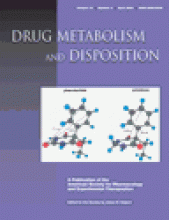Abstract
The purpose of this study is to investigate reliable prediction methods for in vivo pharmacokinetics and the likelihood of drug interactions with several cytochrome P450 inhibitors in humans for (S,S)-3-[3-(methylsulfonyl)phenyl]-1-propylpiperidine (PNU-96391). By allometric scaling of in vivo animal data, clearance of PNU-96391 in humans was over-predicted by 4-fold, half-life was under-predicted by 3-fold, and volume of distribution was accurately predicted. High correlation coefficients (>0.99) were observed for these parameters. Neither the in vitro-in vivo correlation approach nor the modified allometric scaling with maximum life span potential or brain weight accurately provided the predicted clearance value. Using an alternative method, based on normalization of in vitro human data with the ratio of in vivo to in vitro animal data, the in vivo clearance in humans was predicted to be 0.39 l/h/kg. This value correlated well with the in vivo value (0.43 l/h/kg). Regarding the interactions of PNU-96391 with cytochrome P450 inhibitors, only quinidine, haloperidol, and ketoconazole showed significant inhibition on the metabolic clearance of PNU-96391 in human hepatocytes. By comparing in vitro Ki values with in vivo maximum unbound concentrations of the inhibitor, the increases in systemic exposure of PNU-96391 by coadministration of the inhibitors were estimated to be less than 1.5-fold. A preliminary comparison of pharmacokinetics of PNU-96391 between CYP2D6 extensive and poor metabolizers in the clinical study showed only a slight increase in systemic exposure in poor metabolizers (approximately 1.4-fold as area under the concentration-time curve). Therefore, clinically significant drug-drug interactions of PNU-96391 would be unlikely to occur with coadministration of CYP2D6 inhibitors.
Footnotes
-
↵2 Abbreviations used are: PNU-96391, (S,S)-3-[3-(methylsulfonyl)phenyl]-1-propylpiperidine [(-)-OSU6162]; AUC, area under the concentration-time curve; AUMC, area under the first moment curve; BW, brain weight(s); CLblood, blood clearance estimated from in vivo study; CLint, intrinsic clearance estimated from in vitro hepatocyte study (intrinsic hepatic clearance); CLhep, hepatic clearance estimated from in vitro hepatocyte study; CLplasma, plasma clearance estimated from in vivo study; Fa, fraction absorbed; fm, fraction eliminated by hepatic metabolism; fu, unbound fraction in plasma; Iin,max,u, maximum unbound concentration of the inhibitor in the portal vein; Imax, maximum concentration of the inhibitor in circulating blood; ka, absorption rate constant; kel, elimination rate constant; Ki, inhibition constant; LC/MS-MS, liquid chromatography/tandem mass spectrometry; MLP, maximum life span potential; Qh, hepatic blood flow; Rb, blood to plasma concentration ratio; t1/2,z, terminal elimination half-life; Vss, volume of distribution at steady state; W, body weight; P450, cytochrome P450; PK, pharmacokinetic.
-
↵1 Current address: Pharmacokinetics, Dynamics and Metabolism, La Jolla Laboratories, Pfizer Inc., 10724 Science Center Drive, San Diego, CA 92121.
- Received July 24, 2003.
- Accepted December 19, 2003.
- The American Society for Pharmacology and Experimental Therapeutics
DMD articles become freely available 12 months after publication, and remain freely available for 5 years.Non-open access articles that fall outside this five year window are available only to institutional subscribers and current ASPET members, or through the article purchase feature at the bottom of the page.
|






